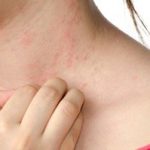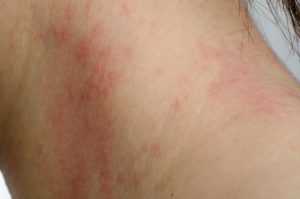Contact dermatitis is a rash caused by a direct contact with an allergen. Essentially, it’s any red, inflamed skin reaction to coming into contact with something that it finds irritating.
Advertisement
The good news is it’s not contagious or life-threatening, but it can be awfully painful and uncomfortable. How long does contact dermatitis last? That depends on identifying what’s causing the reaction, and if the condition is because of a food or substance allergy you may have in allergic contact dermatitis.
On that note, to treat contact dermatitis successfully, you first need to identify and avoid the cause of your reaction. Then if you can avoid the problematic substance, the rash usually clears up in two to four weeks. Quick remedies include soothing your skin with cool, wet compresses and anti-itch creams and lotions.
Causes of contact dermatitis
 When it comes to facts about dermatitis, a good starting point is the causes of dermatitis. The painful inflammation can come from a range of plants or substances, including the following:
When it comes to facts about dermatitis, a good starting point is the causes of dermatitis. The painful inflammation can come from a range of plants or substances, including the following:
- Soaps
- Cosmetics
- Fragrances
- Jewelry
- Plants such as poison ivy or poison oak
- Chemicals for hair treatments
- Chemicals for cleaning
- Industrial chemicals
Some people are exposed to substances at work that may cause contact dermatitis. Those jobs that require frequent exposure to heat and water, such as food preparation, dishwashing, hair styling, janitorial staff, even health care professionals, can make skin more prone to irritant contact dermatitis. Although it normally affects the hands and forearms, it can occur in any part of the body that comes into contact with the substance.
In allergic contact dermatitis, as with any allergy, the body’s immune system reacts to an allergy-causing substance which isn’t normally harmful. These types of skin allergies are all too common. They affect about one-quarter of Americans at some point in their lives. Again, those allergies have a variety of causes, and bring on similar rashes and other symptoms of dermatitis.
Signs and symptoms of contact dermatitis
 What are the telltale signs and symptoms of dermatitis? It’s good to know what to look for. You’ll know soon enough – the reaction usually happens within minutes to hours of exposure and if you’re wondering how long does contact dermatitis last, you could be looking at an uncomfortable two weeks.
What are the telltale signs and symptoms of dermatitis? It’s good to know what to look for. You’ll know soon enough – the reaction usually happens within minutes to hours of exposure and if you’re wondering how long does contact dermatitis last, you could be looking at an uncomfortable two weeks.
The signs and symptoms of dermatitis include:
- Red rash or bumps
- Itching, which may be severe
- Dry, cracked, scaly skin, if your condition is chronic
- Blisters, draining fluid and crusting, if your reaction is severe
- Swelling, burning or tenderness.
The severity of symptoms really depends on how long you’re exposed, the cause and your genetic makeup, which may affect how you respond and eventually heal.
Important to note, too, is when to seek medical attention. As the Mayo Clinic advises, do so if
- You think your skin is infected (fever and pus oozing from blisters)
- Your lungs, eyes or nasal passages are painful and inflamed
- You think the rash has damaged the lining of your mouth and digestive tract
- The rash is so uncomfortable that you are losing sleep or are distracted from your daily routine
- The rash is painful, severe or widespread
- You’re embarrassed by the way your skin looks
- The rash doesn’t get better within a few weeks
- The rash affects your face or genitals
While the signs and symptoms of dermatitis aren’t pleasant, once you’ve experienced it, you’ll have a better idea about how to prevent a reoccurrence. Understanding what causes dermatitis – and allergic triggers to which you may be prone – go a long way to protect yourself.
And the next time you’re out orienteering, watch where you’re trekking…
Related Reading
Poison ivy rash affects some people more due to poor handling
Advertisement
Poison ivy is a plant that can cause an uncomfortable and unsightly rash, but it’s important to know that poison ivy rash affects some people more than others due to poor handling and that poison ivy treatment will go a long way in easing rash symptoms. Continue reading…
Dermatitis herpetiformis, skin rash from celiac disease, managed with gluten free diet
Dermatitis herpetiformis is a skin rash from celiac disease which can be properly managed by following a gluten free diet. Dermatitis herpetiformis (DH) is a skin rash which resembles herpes lesions which can appear as blisters and bumps but it is not a form of herpes. Continue reading…

